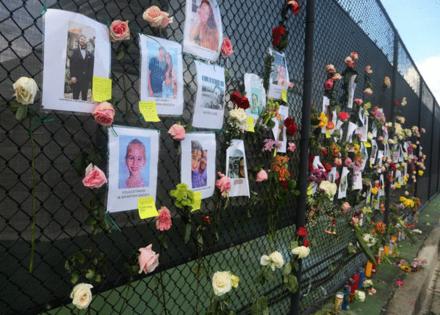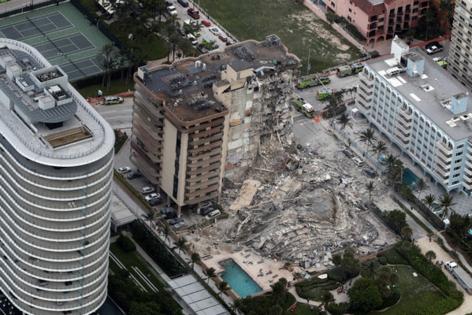4 years after Surfside condo collapse, investigators zero in on design and construction flaws
Published in News & Features
MIAMI — Four years after the collapse of Champlain Towers South killed 98 people in Surfside, investigators piecing together the rubble are homing in on shoddy construction as what most likely caused the 40-year-old beachfront condominium to fall at 1:22 a.m.
“As we have shared in previous updates, there were many design and construction problems that weakened the building from the start,” investigator Judith Mitrani-Reiser said Monday in an update from the National Institute of Standards and Technology. “These deficiencies posed many potential failure initiation possibilities both in the pool deck and the tower ...”
Most of the victims — ranging in age from 1 to 92 years old — were sleeping when two-thirds of the 12-story condo collapsed June 24, 2021. Only three people survived atop the 40-foot pile of debris. No one was found alive after weeks of searching by rescue crews, but the remains of all victims were identified.
Only four people living in the section of the building that fell and the security guard working the night shift in the lobby were able to escape during the seven-minute gap between the time the pool deck caved in and the middle and oceanfront sections of the tower came down.
Residents in the wing that stayed intact managed to get out but were not allowed to return to their homes, and the rest of the building, determined to be unstable, was demolished 10 days later as a hurricane threatened South Florida.
“Two clear questions coming out of this investigation are why the design and construction problems were not discovered when Champlain Towers South was built, and how do we evaluate the structural safety of existing buildings?” said Glenn Bell, co-lead investigator on NIST’s National Construction Safety Team. “These conditions existed from the time construction was complete, 40 years before the partial collapse.”
The team is focusing on three “higher-likelihood” hypotheses out of its initial 12, each arising from construction flaws that doomed the building. The collapse could have been triggered by failure of a slab-column connection in the pool deck, where the structural design did not meet building code standards. Steel reinforcement was missing or misplaced and eaten away by corrosion. Heavy planters and pavers added years later to the poorly draining deck increased the load on a support system “that was already functionally and structurally inadequate,” the report says.
Prolonged exposure to water in the parking garage, where residents had complained about flooding and ponding, corroded steel bars and degraded concrete in the basement columns that were not built to proper strength. Those brittle columns or the failure of a slab-beam-column joint in the southeast part of the tower, close to the pool deck, could have been the cause of the collapse.
“The fact that the pool deck collapsed before the tower does not preclude the possibility that there was some initiating event in the tower that set off the collapse of the very vulnerable pool deck,” Bell said.
A theory that the breaking off of the pool deck from the south basement wall could have started the collapse is now rated “lower likelihood” by investigators, as is the theory that sinking ground could have led to pile failure. Testing found that the limestone on which the foundation sat and the pile concrete were strong enough to support the building, and the basement slab showed no signs of cracking or sinking.
A 2021 Miami Herald investigation broached some of the same scenarios, with University of Washington engineering professor Dawn Lehman finding that skinny support columns that did not comply to code were clustered below the part of the structure that experienced progressive collapse. Given the design, “it’s amazing to me that something didn’t (fail) earlier,” she said.
Misplacement of rebar meant “all of the columns were cracking from day one,” local structural engineer Eugenio Santiago told the Herald.
No records from the original construction have been found, hampering the investigation. The apparent lack of quality control in the Champlain Towers South case should be a red flag to engineers and builders, Mitrani-Reiser said, noting the importance of retaining initial drawings, quality assurance reports and peer reviews.
“This tragic event has revealed flaws in our systems, and quality is at the heart of it,” she said.
The principal investors, architects, engineers, contractors and Surfside officials involved in the construction of Champlain Towers are deceased. Developer Nathan Reiber, a Canadian lawyer who retired to South Florida and became a real estate mogul, died at age 86 in 2014 while living in a Star Island house.
The three-condo Champlain Towers complex was a huge development for the quiet, low-rise town of Surfside in 1981, when it was completed. Reiber obtained exceptions to building department rules, in part by giving the town $200,000 so it could upgrade its sewer system and lift a construction moratorium. The project was stalled again when town staff suspected that the penthouse at the top of the south tower exceeded Surfside’s 12-story height limit. But the town council approved it.
One year after the collapse, the $1.1 billion settlement of a class-action lawsuit was approved by Miami-Dade Circuit Court Judge Michael Hanzman. Wrongful death and personal injury payments ranged from $35 million to the family of one victim and $50,000 to some survivors. Securitas Security Services USA, which said in a deposition that the building’s alarm system was not activated the night of the collapse, paid nearly half the total. The condo association’s law firm and consulting engineer on its 40-year recertification, and developers and builders of the luxury condo next door, were among the three dozen defendants.
Dubai-based DAMAC International plans to finish a new “ultra luxury” condo on the Champlain South site by 2029. The Delmore, designed by Zaha Hadid Architects, will feature 37 “mansions in the sky” starting at $15 million and served by residential butlers.
NIST’s final report is expected in 2026.
“We intend for our investigation of this failure to have a lasting impact, save future lives and ensure this never happens again,” Mitrani-Reiser said.
_____
_____
©2025 Miami Herald. Visit miamiherald.com. Distributed by Tribune Content Agency, LLC.










Comments